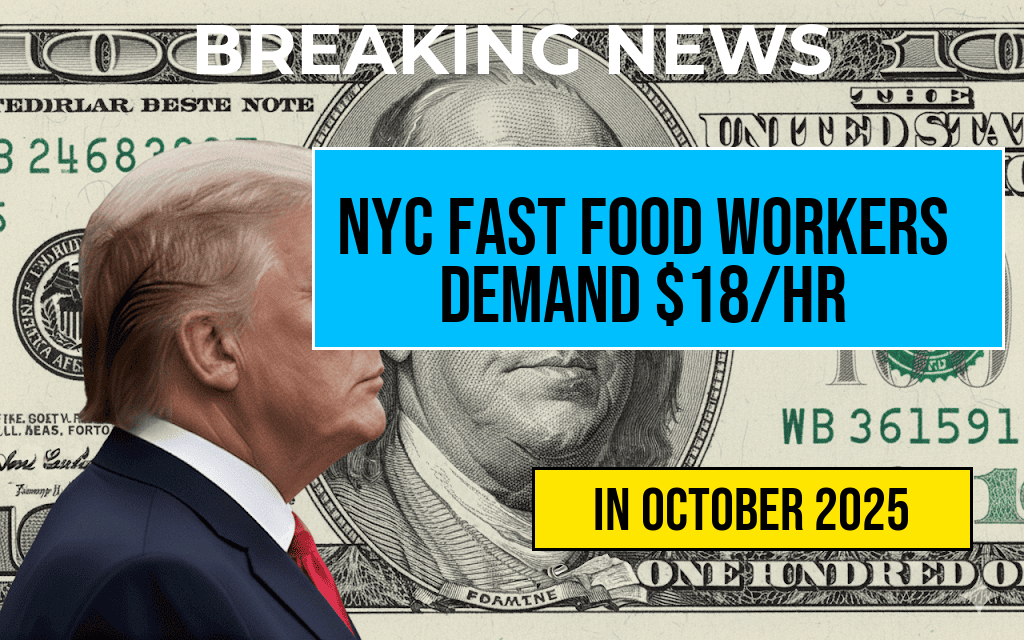Fast food workers across New York City are escalating their efforts to secure a higher minimum wage, advocating for an $18 an hour baseline that they argue reflects the rising cost of living and their contributions to the city’s bustling economy. Organized labor groups, along with individual employees, have launched a coordinated campaign demanding that the city’s largest fast food chains commit to this wage increase. The movement arrives amid ongoing debates about fair compensation in sectors characterized by high turnover and demanding working conditions, with workers citing financial instability and the need for improved job security. As restaurant chains face mounting pressure from advocacy groups and public opinion shifts, city officials are also weighing potential policy adjustments to address wage disparities. The campaign underscores a broader push for economic justice and highlights the challenges faced by a workforce essential to New York’s vibrant food scene.
Background and Context of the Wage Campaign
Fast food workers in New York City have long battled for better wages, citing the city’s high living costs and the physically demanding nature of their roles. The campaign for an $18 an hour minimum wage builds on recent efforts to raise wages in low-paid sectors, especially following the statewide minimum wage increase to $15 in 2019. However, many workers argue that $15 remains insufficient to cover basic expenses in a city where housing, transportation, and healthcare costs continue to surge. Advocates point to studies indicating that a wage of at least $18 per hour would enable workers to meet their needs without relying on public assistance or overtime.
Support from Labor Groups and Workers
Labor organizations, including the Service Employees International Union (SEIU) Local 1199 and Fight for $15, have been instrumental in mobilizing fast food workers. These groups organized rallies and protests in recent weeks, featuring workers sharing personal stories of financial hardship. “We’re not asking for a handout, only fair pay for our hard work,” said Maria Lopez, a cashier at a prominent fast food chain in Manhattan. “We want to be able to afford rent, healthcare, and the basics without stress or fear of losing our job.” The campaign has garnered widespread support among workers who see the wage increase as a step toward economic dignity and stability.
Responses from the Fast Food Industry
Major fast food corporations operating in New York City, such as McDonald’s, Burger King, and Wendy’s, have largely resisted calls for an $18 minimum wage, citing concerns about increased labor costs and potential impacts on employment levels. A spokesperson for one leading chain stated, “While we recognize the importance of fair wages, the economic realities of running a business in a highly competitive environment limit our ability to meet such demands immediately.” Industry analysts suggest that these companies are weighing the potential for automation and efficiency improvements as alternatives to wage hikes, though critics argue that such measures threaten job security for low-wage workers.
Policy and Political Context
| Year | Minimum Wage | Notes |
|---|---|---|
| 2019 | $15.00 | Statewide minimum wage increase for large employers |
| 2023 | $15.00 | Standard minimum wage, with calls for regional adjustments |
| Proposed 2024 | $18.00 | Advocated specifically for fast food workers in NYC |
City officials have expressed openness to revisiting minimum wage policies but have emphasized the need for balanced approaches that consider economic viability for businesses. Mayor Eric Adams has acknowledged the importance of fair wages but cautioned against rapid increases that could lead to unintended consequences like layoffs or increased prices for consumers. Nonetheless, the campaign has reignited discussions about equitable pay and the role of the city government in setting wages that reflect the cost of urban life.
Economic Implications and Broader Movements
Analysts observe that increasing the minimum wage for fast food workers could have ripple effects across multiple sectors, potentially setting a precedent for other low-wage industries in New York City. Proponents argue that higher wages would reduce turnover, improve employee morale, and enhance service quality. Conversely, opponents warn of the risk of higher menu prices and potential job cuts, particularly for entry-level positions.
According to data from the [Bureau of Labor Statistics](https://www.bls.gov/), fast food and counter workers in urban areas tend to earn less than their counterparts in suburban or rural regions, underscoring the disparities within the industry. The push for an $18 an hour minimum wage reflects a broader national movement advocating for living wages, with cities like Seattle and Los Angeles experimenting with similar policies.
Community and Consumer Perspectives
Community organizations and consumer advocacy groups have voiced support for the wage campaign, emphasizing the importance of supporting workers who keep the city running. “When fast food workers earn a living wage, it benefits entire neighborhoods,” said Jasmine Carter, director of a local community development nonprofit. “It reduces reliance on public assistance and stimulates local economies.” Some consumers have expressed willingness to accept modest price increases if it means fairer pay for essential workers, highlighting a shift in public attitudes toward corporate responsibility and social equity.
Looking Ahead
The campaign for an $18 an hour minimum wage in New York City continues to gain momentum, with organizers planning additional actions in the coming months. While industry representatives remain cautious, city policymakers face mounting pressure to address wage disparities amid ongoing economic recovery efforts. The outcome of this movement could influence wage standards across New York and set a precedent for other major urban centers grappling with similar issues.
Frequently Asked Questions
What is the main goal of the New York fast food workers’ campaign?
The primary goal of the campaign is to achieve a $18 an hour minimum wage for fast food workers in New York City to improve their working conditions and financial stability.
Why are fast food workers in NYC advocating for a higher minimum wage?
Fast food workers are advocating for a higher minimum wage to address low pay, economic hardships, and to ensure they receive a fair living wage that reflects the high cost of living in New York City.
How might this campaign impact fast food workers and the local economy?
If successful, the campaign could lead to better wages for workers, increased job satisfaction, and potentially stimulate the local economy through higher consumer spending by workers with increased income.
What actions are fast food workers taking as part of this campaign?
Fast food workers are participating in protests, strikes, and advocacy efforts to raise awareness and pressure policymakers to raise the minimum wage to their targeted $18 an hour.
What challenges does the campaign face in achieving its goal?
The campaign faces challenges such as opposition from business owners, policy resistance, and the need for legislative changes to increase the minimum wage across the city, which requires widespread support and advocacy.






